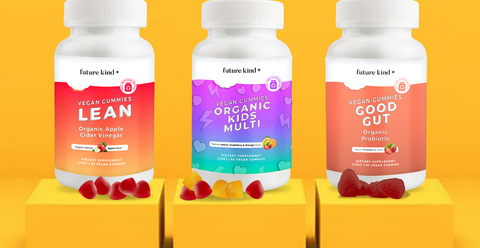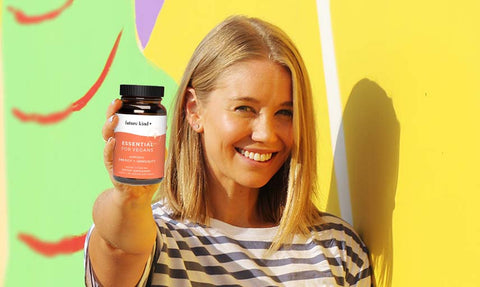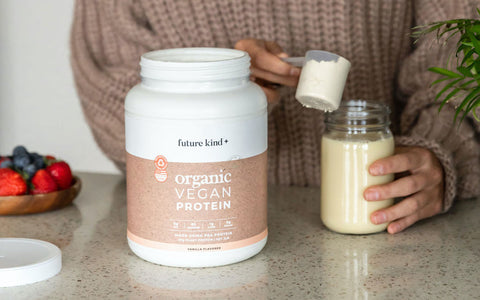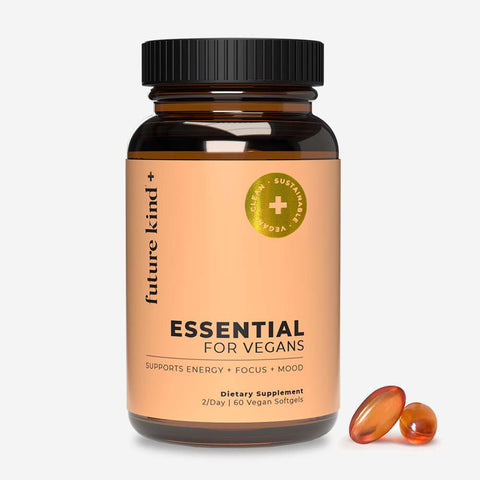By now you've heard of the seemingly mysterious, miraculous ingredient that is aquafaba. But we get it, you still have some questions about this unique egg substitute.
Here's everything you need to know!
What Is Aquafaba, Exactly?

Nothing but a can of beans—quite literally.
While the name might sound fancy, like a high-end lotion or designer perfume, aquafaba is simply the name given to the viscous, jelly-like brine found in canned legumes such as chickpeas.
We know what you’re thinking—it didn’t sound that appealing to us either, at first.
Still, aquafaba has been considered a miracle ingredient for three main reasons: it’s incredibly inexpensive to make, it’s fat-free, and it can replicate the function and texture of eggs to absolute perfection.
Omelettes, French toast, pavlova, mousse, mayo, and much much more—aquafaba can get anything done just the way eggs can.
If you are living an egg-free lifestyle, you don’t know how good your baking can get until you’ve tried aquafaba. You’ll want to always have an emergency can of chickpeas always stored in your pantry!
The Origins of Aquafaba

So, how did aquafaba come about to dominate egg-free baking?
The history of this creative substitute is quite fascinating and rooted in online community effort.
Let’s go back to 2014, when in the very not vegan-friendly France, Joel Roessel begins experimenting with chickpea water to create beautiful foams. As his meringue recipe videos start wowing Europe, the United States catches wind of the latest plant-based innovation through a new Facebook group: Vegan Meringue – Hits and Misses. It is around this time that the term “aquafaba” is coined, standing as a loose Latin translation of water (aqua) and fava (bean).
This group effort was essential to get us to where we are today, and as more recipes were shared and more members started joining the experiment, vegan blogs and major publications alike were quick to catch up with the trend.
The story of aquafaba is truly a testament to the power of social media to connect and innovate the food industry!
The Freshest Trend – Aquafaba’s Growing Popularity
Although the aquafaba buzz started to whisk up an online storm back in 2015, it’s truly conquered the web now, going well beyond food science and meringue experimentation alone.
Google searches for the unusual word have gradually increased over time, reaching their peak in 2020.
The figures seem to follow the increasing interest in the vegan lifestyle that has dominated the past five years, but the aquafaba phenomenon is not an exclusively vegan trend.
In fact, it has become a miracle ingredient for anyone wishing to avoid eggs for allergy reasons, for those seeking to reduce food waste in their daily lives, and for people looking to save a buck or two.
Types of Aquafaba and How to Use Them

If you’ve heard of aquafaba before, you probably have always thought of it as canned chickpea water.
Time to expand your bean water horizons!
Aquafaba can be made out of all sorts of canned beans, each with its own best recipe use. Here we list the most common varieties and what they are best suited for.
Chickpea Aquafaba
Undoubtedly the most common type of aquafaba, chickpea water owes its popularity to its subtle flavor, making it the perfect egg substitute for both sweet and savory recipes.
Aquafaba mayo is the best example of how canned chickpea water can be used to create a fluffy, light foam with just the right amount of saltiness. It’s simply the closest plant-based substitute for egg whites.
Canned chickpeas are also the most accessible canned beans for many, in terms of both price and availability. A can of chickpeas is definitely a staple that should always be in your cupboard!
White Bean Aquafaba
Although some people swear by chickpea aquafaba being the best egg-free baking substitute, there’s evidence pointing towards other bean waters working even better for specific recipes.
White bean aquafaba (from either cannellini or butter beans) has a more neutral taste than chickpea water, and while it might not make for the lightest fluff, it can be used as a binding agent in baking cakes or savory tarts.
White bean aquafaba is the perfect ingredient to use in spreads like vegan butter, or even dairy-free mozzarella!
Black Bean Aquafaba
Finally we have black bean aquafaba, quite distinct from the previous two varieties with its dark color and stronger taste.
Black bean water is best suited for chocolate-heavy recipes that will mask its color and complement the more intense bean flavor.
If you are one to enjoy black bean brownies, you already know half of the magic! You can use black bean aquafaba to whip up perfect gooey brownies or a rich chocolate mousse.
The Science Behind Aquafaba
So, how does aquafaba work? Surprisingly enough, the science of aquafaba is still much of a mystery.
According to a study from 2018, aquafaba’s key components of polysaccharides, sucrose, and proteins closely resemble the ones of egg whites. It comes as no surprise that the two ingredients will behave in a very similar way when whisked or cooked.
In regards to aquafaba’s foaming properties, the culprit appears to be compounds called saponins, which can produce a creamy foam when shaken vigorously.
The science is still unclear on the reason why chickpea water, as opposed to other types of bean aquafaba, makes for the softest foam.
How to Make and Store Aquafaba

Making your own aquafaba is incredibly fast and easy.
Drain the water from a can of beans into a bowl, making sure there aren’t any shells floating around. Your aquafaba is technically already ready to go!
If you want to use aquafaba as a binder in savory and sweet bakes, you may use it a-is, or lightly foam it by whisking or blending.
For whipped aquafaba (ideal for meringues, icing, or cocktail foams) you can use either a hand mixer or a stand mixer to whip the liquid into a white, fluffy foam. Please don’t attempt whisking by hand unless you are extremely confident in your strength and stamina!
It will only take a maximum of ten minutes to get medium or semi-firm peaks with an electric mixer. At this stage, you might want to use some cream of tartar, white vinegar, or lemon juice to stop your peaks from collapsing.
It’s very unlikely you will use all the aquafaba in one go. So, if you are wondering how to store leftover aquafaba for later use, you’ll be happy to know it will keep in the fridge for up to a week.
Don’t think you’re going to use it all in a week either? No need to worry, it can be frozen too!
We recommend putting one tablespoon into each cavity of an ice cube tray, so you can pre-portion ahead of time and make sure you are extra precise with your baking measurements.
A Perfect Baking Substitute

Are you planning to use aquafaba as an egg substitute in baking? Make sure you know how its measurements work first.
As a general rule of thumb, one egg white equals two tablespoons of aquafaba, while one tablespoon will make for one egg yolk, and three for a whole egg.
Be careful however, these measurements refer to aquafaba straight from the tin or cooking pot, not its whipped form!
You can use aquafaba to give your pancakes and muffins an extra lift, make chocolate mousse, brownies, macaroons, and meringues—or anything else your imagination can come up with!
The Ultimate Diet Food: Aquafaba Nutrition
It seems like there’s almost no limit to what you can achieve with this humble bean water, but is aquafaba healthy and good for you? Let’s take a closer look at its nutritional content.
As leftover water, aquafaba is certainly not loaded with vitamins and nutrients, but its low calorie content makes it perfect diet food. One tablespoon of aquafaba contains only about 3-5 calories, zero fat, and traces of protein and calcium.
If we compare that to one egg yolk, which packs in around 55 calories and 4.5 grams of saturated fat, it’s easy to see which one might be friendlier to your waistline.
Still, it could be argued that the protein found in egg yolks and whites might help dieters stay full for longer. But what are the chances you’ll be going full Rocky on raw eggs anyway?
If you are thinking of making delicious homemade mayo, pancakes, or just a little dessert mousse, aquafaba is the perfect diet-friendly ingredient to make your treats that much lighter!
The Canned Criticism

Not everyone has been fawning over the wonders of aquafaba like the rest of the web seems to be.
You won’t have to go very far in your search to come across a number of blogs criticizing the popularity of the substitute, citing the lack of nutritional value and the dangers of canned beans as the main setbacks of cooking with aquafaba.
Canned beans from a tin, or any other canned food for that matter, might contain traces of BPA. This industrial chemical is used to coat the metal in most food cans, and some research has shown that the chemical can seep into the food and brine stored inside.
The potential dangers of BPA haven’t been fully explored yet, and while there is some scientific talk of the chemical being a hazard to children’s development, we are still far from having definitive answers.
Furthermore, the FDA has stated that the small quantities of BPA that are sometimes found in canned food are completely safe to be consumed.
If you’d rather be safe than sorry and avoid all possible exposure to BPA, you can look into buying canned goods that are labeled BPA-free, get your pre-cooked chickpeas from glass jars, or simply cook dry beans from scratch to make aquafaba.
There’s just one question left to answer: will these different sources of aquafaba give you the same fluffy, magical results?
The Great Aquafaba Experiment - Cooked vs. Canned Beans
Faced with mixed experiences and diverging opinions online, we have decided to put this to the test.
We have made a delicious, egg-free aquafaba mayo using only 5 ingredients: 3 tbsp aquafaba (from a chickpea tin), ½ tsp apple cider vinegar, ½ tsp lemon juice, 1/4 tsp mustard, and one cup of vegetable oil.
And what does the mayo look like using the leftover water from a pot of cooked chickpeas, instead?
Using the exact same ingredients, we recreated the aquafaba mayo recipe using three tablespoons of leftover water, straight from the chickpea pot. The result?
The consistency is overall identical, with the exception of a few air bubbles that we could find on the surface of the tin aquafaba mayo, not present in the cooked chickpea water mayo.
The two types of aquafaba mayo are also identical taste-wise—they’re both incredibly delicious.
The verdict is clear: you can make tasty aquafaba mayo using both methods. If you’re health-conscious and don’t mind spending a few more hours in the kitchen, you can definitely make your mayo avoiding canned beans and have it taste and look amazing!
The Best Aquafaba Recipes - Indulgent Treats Made Guilt and Egg-Free
Are you curious to try the cooked vs. canned experiment for yourself?
These three aquafaba recipes are egg-free modern classics bound to wow anyone with just one bite.
Let us know which method worked best!
Classic Aquafaba Meringues

Let’s start with the aquafaba recipe that started a whole online movement: vegan aquafaba meringues!
Start by whipping aquafaba from a can of chickpeas (or cooking water) in a bowl, along with a teaspoon of lemon juice to support its stiff peaks.
This process will take between 10 and 15 minutes, so use this time to preheat your oven to 100C.
As you continue whipping, gradually start adding 100g of caster sugar into the aquafaba bowl, along with a teaspoon of vanilla extract and a pinch of salt.
Spoon the mixture into a baking tray lined with parchment paper. You want to try forming small blobs no bigger than 8cm, and bake in the oven for 1 hour and 20 minutes.
Your meringues should be crispy at the bottom and deliciously fluffy when bitten into. You can add chopped strawberries or dairy-free cream when serving, or devour them just as they are!
Lighter Than Air Aquafaba Whipped Cream

This is probably the easiest aquafaba recipe to make, and also the most versatile.
We recommend using white bean or chickpea aquafaba for best results, as you want your whipped cream to be soft, subtle, and incredibly light.
You are definitely familiar with how to whip aquafaba by now, and that is exactly the first step of making this delicious whipped cream.
Use the water from a whole can of beans, or cooking water if preferred, and whip for about 10 to 15 minutes, making sure to add a teaspoon of lemon juice or 1/4 tsp cream of tartar for stiff peaks.
Using cream of tartar will give you the best results, as the taste of lemon juice or white vinegar might be too overpowering for this recipe!
Halfway through the whipping process, add 2 tbsp. granulated sugar and one tbsp. vanilla extract.
Your mouth-watering aquafaba whipped cream is ready to be put on top of your favorite dairy-free ice-cream, fruit parfait, or homemade vegan chocolate lava cake!
Dreamy Aquafaba Chocolate Mousse

An aquafaba recipe that’s almost too easy to taste this good!
We recommend using black bean aquafaba for the best result: a mousse that’s rich, creamy, and unbelievably light.
Start by melting 100g of dark chocolate, along with a generous splash of your favorite plant-based milk, on a double boiler or in the microwave. Once fully melted, put the bowl aside to cool down.
Next, start getting your whipped aquafaba ready. Whip three tablespoons of black bean aquafaba with a hand mixer, adding a teaspoon of lemon juice to stop the stiff peaks from collapsing. Finally, add a tablespoon of caster sugar and continue whipping until you reach a fluffy, stable consistency.
Grab your bowl of melted chocolate and gently pour it in the whipped aquafaba, folding the mixture with a soft spatula until the two ingredients are completely mixed together.
Let the mousse set in the fridge for five hours, and there you have it! A perfectly creamy, rich vegan chocolate mousse to indulge in, totally guilt-free.
You can also top it with your homemade aquafaba whipped cream for the ultimate aquafaba treat!
Five Aquafaba Brands That Belong on Your Grocery List
Up until quite recently, aquafaba was an exclusively homemade, grassroots product.
In the past few years, however, established brands and independent food companies have seen the opportunity of mass-produced aquafaba products appealing to vegans and non-vegans alike.
Here are five pioneers who have begun to spread the genius of aquafaba to the world with products that are convenient, innovative, and incredibly tasty.
Sir Kensington’s – Fabanaise
One of the very first aquafaba products to hit the market, Sir Kensington’s Fabanaise (now simply branded as Vegan Mayo) launched in 2016, and it has everything you could ask for in an aquafaba mayo.
Incredibly light and fluffy, their mayo comes in four flavorful varieties including chipotle and avocado mayo – perfect on a kick-ass sandwich.
You can find this brand at Walmart or on online platforms like Thrive Market and iHerb.
OGGS – Chocolate Fudge Cupcakes and Aquafaba
OGGS’ chocolate cupcakes stand out from other plant-based cupcakes with their moist texture and their incredibly airy icing, soft and light in the way only aquafaba can create.
Their baking substitute (simply branded as “aquafaba”) hasn’t launched yet, but the hype is enough for it to deserve a spot on this list.
You can find their scrumptious cakes and cupcakes at various Sainsbury’s and Waitrose shops across the U.K., or online at The Vegan Kind supermarket.
Fora Foods – FabaButter
Fora Foods’ FabaButter is a Michelin star chef-approved aquafaba butter, first debuted in 2018 among stellar reviews from Forbes, the New York Times, and many other major publications.
Made from a mixture of aquafaba, coconut oil, and vegetable oil, this plant-based butter is able to brown, clarify, and spread just like dairy butter. According to food experts, this is the closest a vegan substitute has ever come to mimicking traditional butter – likely thanks to the wonder of aquafaba!
You will only be able to get this incredible product on Fora Foods’ website for now, as they have just launched a new and improved formula that’s said to be a 1:1 substitution for every single butter application.
Rubies in the Rubble – Plant-Based Mayo
Plant-based condiment brand Rubies in the Rubble is committed to eco-sustainability by fighting food waste with products created from scraps–aquafaba being a prime example.
Their aquafaba mayo comes in two varieties, classic and chilli, that are perfect for dressing burgers, fries, and sandwiches.
You can find these products at Sainsbury’s all across the U.K., or online on the brand’s official website.
Vor Foods – Vor Aquafaba Powder
Aquafaba in powder form? Vor has got you covered.
This is the perfect option for those looking for a shelf-stable, convenient, and quick egg substitute. The fine powder can be used in all types of baking by just adding water, and one jar is set to last you for a really long time–the equivalent of 42 eggs!
If you’re planning to use aquafaba sparingly, this is the right choice for you, as one jar will keep for up to two years, no refrigeration required.
You can find their products in various health food stores across the U.S. and online, Amazon included.
Full of Beans – the Future of Aquafaba in the Market

The story of aquafaba has just begun, and there are many things we still don’t know about the way it works and the possibilities it may open up in the future. The canned vs. cooked debate is still on, and it might take many more other experiments to decide on a true winner.
One thing is clear however: aquafaba is not going anywhere, and it will continue to raise the interest of food scientists and retailers all over the globe. There may soon be a lot more brands to add to our list!
In 2019, aquafaba was identified as one of the trailblazing food trends of the year by supermarket giant Waitrose, five years after its initial “discovery”.
It’s not unreasonable to predict that in another five years, aquafaba will have moved from being a plant-based trend to a world-favorite kitchen staple–and we can’t wait to see it!








Comments (0)
There are no comments for this article. Be the first one to leave a message!